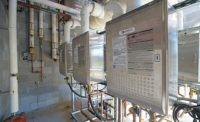I recently received a frantic text message from my wife saying she forgot an important business card on the kitchen counter.
In the old days, that would require either reading the information to her on the phone or hand-delivering it. Thanks to modern technology, I took a photo of the card with my smartphone and texted it to her. Problem solved.
Have you ever wondered what we would do without all this technology? I also wonder what types of new gadgets and technologies we will be playing with 20 years from now.
Speaking of the future, 2015 is now several weeks old (and hopefully you had an enjoyable holiday season), which means now is as good a time as any to take a look at what the near-term holds for this industry.
I checked in with ITR Economics’ Alan Beaulieu, whose forecasts have drawn packed houses at each of the last three NetworkASA gatherings, to get his take on the first part of 2015. He was rather optimistic last September in Las Vegas and remains the same way, thanks to the current oil situation.
“Lower oil prices mean lower gasoline and heating costs for millions of customers and it could not come at a better time,” he said. “Consumers are at least getting a break despite feeling health-care and rent pricing pressures. On balance, the U.S. is in good shape as we head through the first half of 2015 and, by extension, we will help keep the rest of the world from slipping into a mild recession. A hearty thank-you is in order to all those oil-producing nations, including the U.S., who have refused to cut production as they seek to hold onto market share.”
Not a bad forecast to kick things off.
Another topic of great interest in the industry in the first part of 2015 is the forthcoming changes to the National Appliance Energy Conservation Act that will require higher Energy Factor ratings on many residential gas, electric, oil and tankless gas water heaters. The changes, which go into effect April 16, will be felt throughout the supply chain from manufacturers (adjusting products to conform), to wholesalers/reps (inventory changes) and to contractors/engineers/end users (pricing and installation changes).
BNP Media’s Plumbing Group, which includes Supply House Times and sister publications Plumbing & Mechanical, pme and Reeves Journal, recently conducted a poll on their respective websites asking readers if the company they’re working for is ready for the upcoming regulations. The results showed varied levels of preparedness throughout the supply chain.
With PM’s readers, predominantly made up of plumbing and mechanical contractors, 46% of survey respondents say they need more education on the subject. On the engineer side, 50% of pme’s readers (mainly plumbing and mechanical engineers) say they, too, could use more schooling on the subject. Reeves Journal, which reaches contractors, engineers and distributors in 14 Western states, had 75% of respondents check the more education box.
The results were slightly different on the distribution end. Fifty percent of Supply House Times readers say they need more education, but 42% note their company is ready for the change.
I gained some firsthand insight into this during the annual Supply House Times-American Supply Association roundtable interview conducted during NetworkASA 2014. You’ll find the distributor panel’s responses to the new water heater regulations in this issue. Ted Green and California-based Pace Supply, in particular, are ready for April 16.
From those surveys it is obvious more education still is needed in the final few months here before the new regulations go into effect. Manufacturers have done a good job of getting the word out. A few quick examples include Bradford White (webinar on its website), as well as Rheem and A. O. Smith (dedicated landing pages on websites), and there are many more. The U.S. Department of Energy also has an informative page located at tinyurl.com/lkzfjbq. Take advantage of these educational channels.
While there has been plenty of debate pro and con on these new regulations, one thing is certain. Unprepared members of the supply chain will be adversely affected from a financial standpoint.
In order to prevent a domino-like headache from occurring this spring, all parts of the supply chain need to continue to help each other and spread the word about the new regulations. If you are a distributor or a rep, keep educating your customers on this topic.
Make sure you and your customers are ahead of the game, and your 2015 will get off to a positive start!
HELPFUL LINKS:





